A Filmmaker's Guide to Horror Techniques Used in 'The Conjuring' Universe
Study, Experience, and Analysis

(This article will focus on the following films within the Conjuring Universe respectively: The Conjuring, The Conjuring 2, and The Nun. If you would like to get the best insight from this article, it is recommended that you watch each film at least once).
There's a difference between themes and techniques, but they are always linked together. A theme is the idea that is repeated throughout the piece to create meaning and the technique is the way in which that is put forward to the audience through cinematography and design. In this article, we are going to focus on the ways in which this is done in TheConjuring Universeand how effective it has been for a very successful film franchise. Hopefully, this can help you on your way to your next big project.
First and foremost, we're going to look at the five main horror themes portrayed in the films. They are as follows:
- Possession
- Haunting
- Religion
- Violence
- History
Each of these plays a part in the creation of a universe that uses many of the archetypes of horror that both filmmaker and audience are highly familiar with. The difference is the way in which they are used and the reason why they are effective.
In each of these themes, we're going to look at each of the films in the franchise in order to understand its ability to create, effect and sustain the success in the horror genre that it has. Our two main questions are:
- How does the theme work in the film?
- What kinds of camera/lighting/design techniques are used to achieve this?
1. Possession - 'The Conjuring'
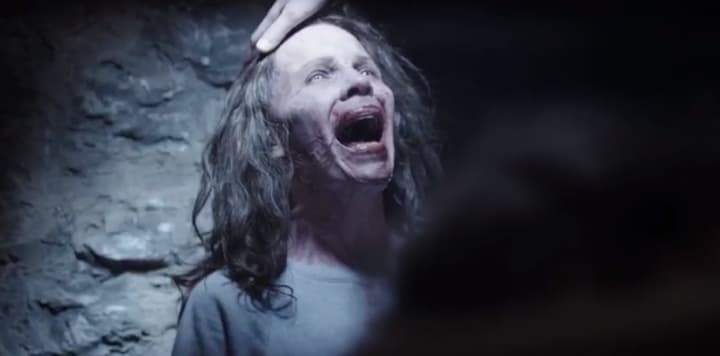
This is the still we will be analysing, you will find it again slightly further on in the article
One of the biggest themes in The Conjuring is possession, purely because possessions themselves are so incredibly terrifying and have a lot of potential when it comes to audience fear. The act of possession removes the person we are familiar with from their own body and replaces them with an imposter. Not only are we scared for the individual possessed, but also for the people in their vicinity. It is more difficult to show the possession of an unknown character [unless that character is a child, as children always create empathy in the audience] than it is to create the possession of a well-known character.
Let's have a look at our questions then:
How does the theme work in the film?
In order for the theme to work, there must be some form of demonic entity established from the beginning of the film, which in this case there is. The Conjuring manages to give us both a physical possession and a spiritual one by showing us what is possessing the mother and by showing the actions of the mother when she is possessed.
What kinds of camera/lighting/design techniques are used to achieve this?
We're going to concentrate on the still in under the heading of the mother with her mouth gaping open as she is possessed.
What do we see in this frame?
Frame
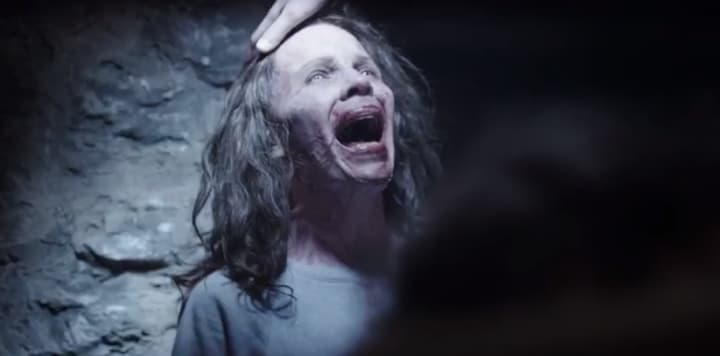
Look at the way it's lit up
Things we can gather from this scene are:
- The light source is in front of the possessed mother and a certain degree above her.
- The room is dark.
- The other person is used to show us where she is in terms of levelling. She's either seated or upon her knees.
- Her shirt is the same colour as the wall, making the scene look darker and blending her face in with the darkness.
The light source being above and in front of the woman shows us that there is something keeping that light source there or had control over the light source; most likely this would be another person.
The fact that there is another person in the room and they are obviously in front of the woman and therefore, a shadow is cast. This is not only a technique of light, but also a technique of the camera angle.
Notice how we don't see the other person in this shot, but instead we see a small fraction of them that slightly obstructs our view of the possession. It shows us there is a shadow as it is casting one. Our view is therefore, mostly obstructed and yet, there is a fear that we have to know that the character will survive.
The other person is shown to be above the woman and therefore, this shows the ability to cast quite a large shadow on the situation and also puts the woman herself in full light whilst the rest of the scene remains in complete darkness either from a shadow or a focused light source. (It is up to you which one you use, but those are the two reasons the rest of the shot is dark).
The colours and design of the shot are very clever as everything is in the realm of that muted grey we see on the back wall that's lit up. This muted grey creates that very strange greyscale feel that we get from a dark atmosphere. It gives the effect of lighting without colour; the only part of the room that is lit is the woman, and yet this requires no bold colours in order to create the cold feeling it gives us since that would destroy the atmosphere.
The colour is a cold and muted grey and the scene is a possession, it works well for creating time and temperature without saying anything about it.
'The Conjuring 2'

This is the frame we will be analysing, you will find it again further on in the article
Even more so, The Conjuring 2 has a better concentration on possession that its predecessor and makes more of an effort to capture audience empathy by having these bad things happen to a child. It is, in my opinion, more effective and better to analyse as the empathy factor nearly always comes into it. Again, this is a character that is not only a child, but also a character we know very well from the film and we are introduced to when she is scared and uneasy about something.
Let's have a look at the questions then:
How does the theme work in the film?
The possession occurs because of an entity that is inside the house. This works two ways in order to create meaning in the film. The first way in which the possession works is so that we can see the effect of whatever entity is in the house on those who live there. The second way it works is for the pure effect of scaring the audience (as some may already be familiar or slightly so with the case of the Enfield Haunting).
What kinds of camera/lighting/design techniques are used to achieve this?
Again, it's that act of lighting only what needs to be lit. It's the way in which colours are used, its the physical shot and the items within the frame that make it come together quite nicely.
Let's analyse the frame then:
Frame

Look at the way in which it is coloured
So, we've concentrated on the lighting and established that, in the case of a possession, the light source would be in front of the character. In this case though, something slightly different is happening in the colours and shot aspect of the frame.
Notice how the background is coloured a greyish-blue on the walls. There are hints of white closer to the character in order to create the amount of light suitable to give us a better look at her face. Since her face is now a porcelain white colour, we can assume that it would only be necessary for her clothes to be a dark colour and, in this case, they are dark brown.
What we see of the clothing is that it is not only dark, but looking closely there is a change of colour, suggesting that there is no a complete difference in the character. The splatters of black that drip down her face are another clue to this and therefore, the possession relies on showing the audience that the character is completely changed from their former selves and something is intruding upon them.
Let's look at the way in which the frame is shot then. Notice how the camera is ever so slightly below the character, making the light source look as if it is coming from something angled slightly upwards. Also, let's notice how the girl's head is slightly tilted downwards to give the effect of pain or mystery; something that creates tension through the character looking as if they don't want to show their face.
The frame is shot in order to get all of those important colours in, showing the contrast between the normal human world in greyish-blue colour and the inhuman world through the way in which the clothes of the girl have been darkened. This is entirely deliberate.
'The Nun'
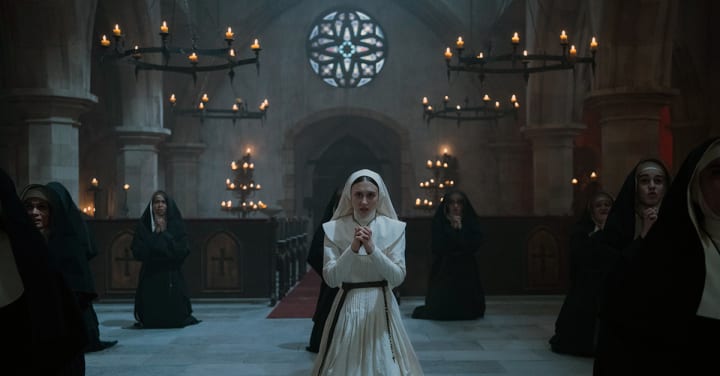
This is the frame we will be analysing, you will find it further on in the article
The way in which this movie shows possession is far smarter than the other two as it is indirect and not shown as your regular possession. Instead, this possession is shown as an intrusion of thought. The demonic nun, Valak, has intruded upon Sister Irene's thoughts and made her believe that the other nuns are still praying in the same room—then destroys it, almost killing them all. In reality, there are no nuns in the abbey apart from Valak and Sister Irene (who takes her vows in the film).
Let's have a look at our questions then:
How does the theme work in the film?
Possession works as we know what the physical Valak can do from the other parts of the film, but instead we are shown how she can get inside the minds of others—most especially, those of religious occupation. The theme is so linked in with the storyline that this invasion of thought is followed directly by the realisation that the other nuns aren't really there and thus creates that possessive, invasive feeling over the character. This will lead up to the bigger possession we see later on in the film.
What kinds of camera/lighting/design techniques are used to achieve this?
As the nature of the possession is slightly different as it is more of an invasion of reality than just of the person. There are slightly different things at play in this frame, including hints and clues that the reality is not actually real.
Let's have a look at the frame again:
Frame

Take a look at this frame and how it has been shot
The camera is angled so that we can see every single person participating in this prayer in the shot, obviously with Sister Irene in the middle. This is highly effective as everything is in a very large space, with the nuns sitting fairly far away from the sister; this suggests that they are trying to cover enough ground in their prayer.
The colours are so that we can mainly see Sister Irene as she is lit up in the middle by the round of candles behind her. I think my favourite part about the colour in the shot is that it foreshadows what's going to happen by the red carpet in between the pews. Sister Irene gains scratch marks on her shoulder, which happens to be lined up perfectly with a blood red carpet.
The levels show us not only that the Sisters are kneeling in prayer, but also where the shadows are being cast. The fact that the nuns are all dressed in black makes the shadowy effect only look darker than it already is. The possessive aspect is that Sister Irene is singled out in the best possible way, through being lit up by the candles, the natural light of the window, the blood red carpet, plus the nuns and their dark shadows upon the floor.
The whole thing is supposed to tell us that there's something happening to Sister Irene and she is what we should be focusing on. The fact that the other nuns are there is supposed to distract our attention, but because they are forced into darkness, it is Sister Irene who is lit up and therefore, who is being possessed.
(As we have noticed, lighting up a particular character in this way is a pattern used to show possession in The Conjuring Universe)
2. Haunting - 'The Conjuring'

This is the frame we will be analysing, you will find it again further on in the article
The act of haunting in The Conjuring links all the films together but also gives us a physical entity of what is causing the possessions and therefore links hauntings and possessions together as well. This is something important to note: your demonic possession is more effective if your demonic entity has a human/physical presence as well as a manifestation in another character. Remember, it isn't The Exorcist, it can't pull that off yet.
Let's have a look at our questions then:
How does the theme work in the film?
This theme allows the filmmaker to work directly with a physical entity that will later possess a character. It also allows for things to happen in the beginning of the film, such as: the empathy towards the haunted family, the slow build up of strange happenings and the increase in tension towards slower tracking shots (we all know this is The Conjuring's forte).
What kinds of camera/lighting/design techniques are used to achieve this?
The filmmaker needs to understand how this frame works in order to understand how the hauntings work in each film. You'll see a pattern here again in the way in which its filmed and the progression of how the films increase in the symbolism and therefore, how the films link together.
Let's have a look at the frame again:
Frame
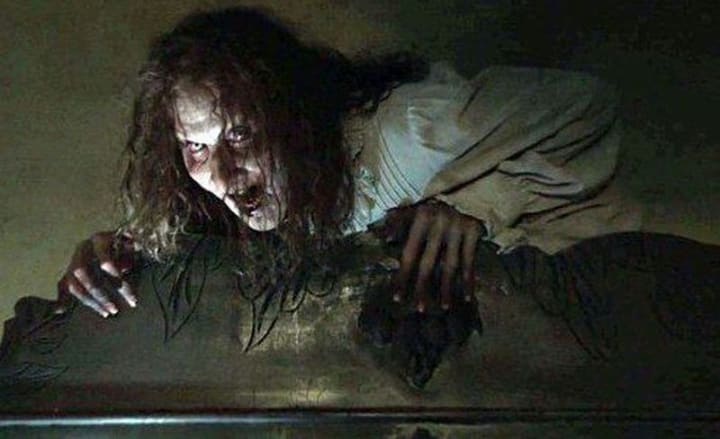
Look at the way it is lit and where the camera is positioned
First of all, we can see some obvious things. They are:
- The camera angle being slightly underneath whatever is haunting the house and therefore, we can understand that the level is quite high up. Even though we see the object the demon is atop of is high up, the understanding of exactly how high up it is comes from this particular use of the camera.
- The camera angle also shows us the space and creates a better sense of haunting by having the demon by having a claustrophobic space.
- The way in which the scene is lit is very effective. We see again the franchise's way of lighting up the face and not much else. In a haunting this can make the audience realise the actual appearance of the demon that is actually haunting the property.
- The design techniques and the colours are quite possibly some of the best in the entire film. Have a look at the way the white supports the lighting on the face, but then again it contrasts the black that's on the rest of the frame.
Second of all, the way these things are all connected in the scene makes the haunting look very invasive. There's a character that looks horrifying, using a remote light source, crammed into a space in which they either don't belong or wouldn't fit.
You have to admit, the way things are achieved in The Conjuring in terms of the hauntings, tie-in so well to the possessions in terms of how they're filmed and how they're given to the audience. Let's have a look at The Conjuring 2 and see exactly how haunting earns its place.
'The Conjuring 2'

This is the frame we will be analysing, you will find it further on in the article
The haunting that takes place in this film is quite clever as it bases itself on something that Ed Warren draws and is something that clearly connects every character in the film. The way in which the haunting takes place is that it's always made clear, if not shown before the possession scenes as to give some sort of physicality to whatever is happening. This is the rule of "show not tell" and, if we were not to do that, then it would feel a bit jarred and then they'd have to explain why they're connected afterwards. Let's have a look at our questions then:
How does the theme work in the film?
This theme is used in almost every single horror film ever made and well, in The Conjuring 2 it is made quite clear that the physical aspect of the haunting is very important for the following reasons:
- To gauge a response from the other characters
- To gauge a response from the audience members, therefore creating a common ground between the audience and characters
- To give the later possession incident a physical aspect
This works very similarly to the first film in the franchise, the difference being that the many different "ghosts" or "entities" in this film are actually all part of the same being.
What kinds of camera/lighting/design techniques are used to achieve this?
The camera, lighting and design techniques of this frame may look very simple, but they are actually quite complex in terms of what it shows the audience about the scene and what is to come.
Frame
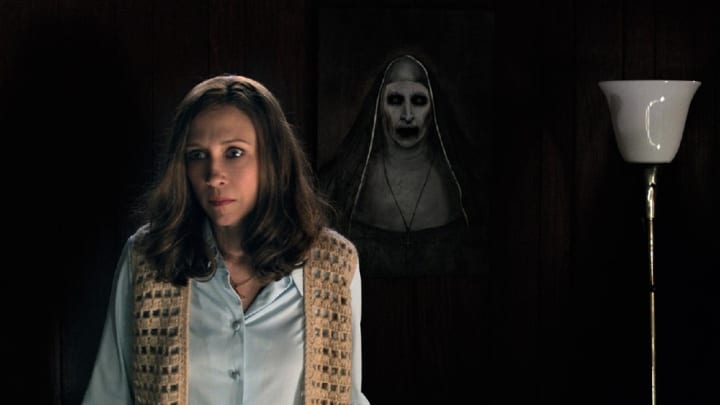
Look at the way colour and lighting is used in this frame
Let's look at the colours first, as it is the most simplistic thing about the frame. The colours of the woman standing in front are muted, as to not only stand out but make it look as if she is lit by a light source, even though the light source (as you would have seen in the last few shots) goes out. This is like an optical illusion in which our eyes are tricked into believing that the scene is well-lit.
Now, that brings us on to the background. The painting behind the woman is most obviously going to be in complete darkness. Notice how we can't really tell where the outlines of the canvas are. Again, this is an optical illusion to make us believe that there's someone standing behind the woman and it's not actually a painting.
We can see, on the left (the character's left) that there is a lamp. This is a bright white lamp that is entirely off and again, it gives us an optical illusion to make us believe the lamp is on instead of off. It also gives some light to the image behind the lamp.
This lighting is repeated over and over again throughout the film. Take a look at this frame of Valak in the hallway and notice the lamp, lighting, shadows and colours. See if you can notice a pattern:
Frame 2

Lighting, the placement of the lamp, colours and shadowing
The lamp is on but doesn't seem to light the demon up very well. We notice that the haunting relies on ill-lighting in order to conduct the proper amount of tension by the way in which it creates shadowing and blurs the lines between the home and the demon.
'The Nun'
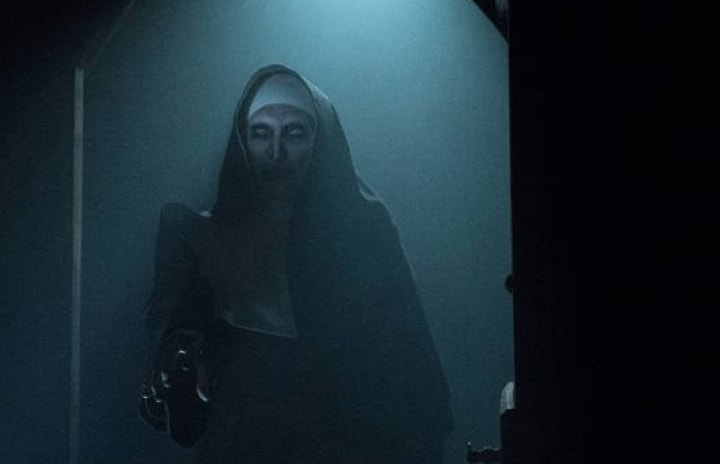
This is the frame we will be analysing, you will find it further on in the article
The haunting of the abbey works so well in The Nun in terms of how it is put across to the audience. The theme of the haunting is to make sure the audience know that this very physical entity is trying to make itself blend in with the others who live in the abbey. The theme makes sure the audience are aware by repeating very similar steps, such as the lights going out as Valak approaches - and therefore, when this happens a third or fourth time, we can recognise it. Let's have a look at our questions then:
How does the theme work in the film?
As we've already established, the haunting of the film uses a set of steps which will make the audience recognise when Valak is approaching. This also creates tension without actually saying anything and therefore, no dialogue is used in these scenes. From the very beginning of the film, this is something that is given to us by a prologue. And because the prologue is so dark and so depressing, when it is repeated, we get the same air. This does not mean repeat the scene; it means repeat the tense atmosphere that causes the scene to be so dark.
What kinds of camera/lighting/design techniques are used to achieve this?
We have to notice how this particular frame is used to heighten the tension and, as always, it is a Conjuring Universe trademark of lighting, angles and colour. Let's take a look at the frame:
Frame

Look at the way the colour, background and atmosphere tend to give things away
I want to first highlight the obvious things:
- The blue tint makes the shadowy figure's white colours stand out but the black colours have a faded and almost smoky look to them
- The black colours of the figure seemingly fade as you descend down the frame, heightening that air of foggy mystery.
- The eyes stand out because of the fact they are a different colour than the used colour scheme in the frame.
Now, let's have a look at the less obvious things that may trick the common viewer:
Look at the light source. The light source is coming from above and so, can only light up one side of Valak's body. Notice how the top is lighter than the bottom though she is standing almost directly underneath the light source; it is because of this blue tint. The blue tint fades out towards the bottom, causing it to fade to black and blend the clothing into the darkness. This is why as she lifts her hand, we can just about see it. This is also why you can see the door frame on the right side of Valak (her right) and why it has been lit up so well.
Notice the space around Valak's eyes, not the black, but the colours around the black that are used to make the dark look darker. There's a very apparent white colour that is used to compliment the greyish skin tone that we constantly see her with. This is used so that we can see the eyes better. It is the eyes that we should be concentrating on because they look nothing like average human eyes and therefore, this is how we recognise that Valak is a demon.
Now, notice how the camera angle is used. We don't see Valak standing in the middle of the frame, but she is sort of to one side. Why is this? This is done for the effect of showing that the haunting takes place whenever it can. This is a POV shot from the point of Sister Irene and, therefore, she would be walking this way at that specific moment. This means that the camera would either have to pan on to the demon, or that it would slowly show the demon in frame as Sister Irene moved closer. The POV shot is used to bring character and audience together in this realisation that there is actually a demon in the room with Sister Irene.
3. Religion - 'The Conjuring'
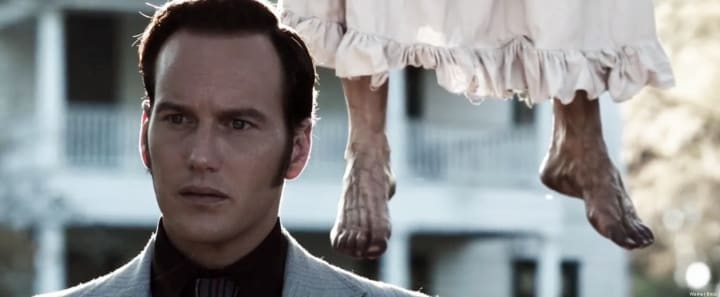
This is the frame that we will be analysing, you can find it further on in the article
This is one of my all time favourite themes in The Conjuring Universe and I can honestly say that it makes good use of the religious themes. It tends to use religion to both link and juxtapose certain ideas, keeping the audience on-edge. To link ideas, it uses religious symbolism like crosses in different areas. To juxtapose ideas it uses a demonic symbol in the form of a religious icon—hence, the demonic nun. Let's have a look at our questions then:
How does the theme work in the film?
This theme works in The Conjuring by giving us things that happen that aren't necessarily religious and because of the fact that the main characters have crosses (which probably means they believe in something) this creates a fright within the audience. This is mainly because we sympathise with the main characters and not with the strange happenings (such as Bathsheba).
What kinds of camera/lighting/design techniques are used to achieve this?
The frame shows us many things about the design of religion and anti-religion in the film and, it is quite symbolic of what will happen in the near future of the film's events. To be honest, it's quite an achievement. Let's take another look at the frame we're using to analyse this:
Frame

Look at the colours and the design used on this frame
Notice the first and foremost thing: the design of the frame. Let's look at the way in which things are designed to make them aged. The most obvious aspect is the dress. The dress has ruffles at the bottom which would never suggest that this character, hanging, had come from the 20th Century. The style and colour of the dress are too old to be so and, of what we can see, the dress is tinted with a greyish-black, again, ageing it even more.
Let's now have a look at the colours, which are less obvious to pick up in the frame. We talked about the greyish-black tint the dress has because of its age. Notice how everything else in the frame (apart from the hanging person) has a very clean and solid colour; there are no fades or tints or dip dyes, everything is a solid colour. Ed's shirt being the most symbolic of them all.
Ed's shirt is black, obviously (even though he isn't) it makes him look like he's dressed as a priest. The fact that there is a person hanging to death behind him has obvious religious juxtaposition (as Christianity believes suicide is a sin).
But, I believe the most iconic thing about this scene is the way it is shot and set up. The hanging character does not look like they are behind of in front of Ed Warren, but instead they look as if they are directly beside him (even though, in reality, it is actually behind him). This is a trick of the frame, another optical illusion by the filmmaker to make us believe that the hanging character is actually there. To have them line up directly with the character in one frame would be important for engaging their presence, especially if that was dependent on a certain set of characters.
'The Conjuring 2'

This is the frame we will be analysing, you will find it further on in the article
The theme of religion in the second film of the franchise is so very important, as it is in the first film. We've talked about physical entities and now, we're looking at many different entities manifested by the same demon. This is playing on massive religious fears that people have felt for centuries.
How does the theme work in the film?
There is a theory that the Crooked Man is actually just Valak in a different form, but the concrete evidence we have is Bill Wilkins being possessed by the demon Valak and therefore having a different form. This is why the ghost of Bill tries to drag Peggy down into the water and bites her.
There is a massively important suggestion at the end of the film that Valak, even though gone, is not finished in the Enfield House. It is suggested through the death of Peggy Hodgkins; if you were paying good attention to the way in which she dies you would've noticed similarities. Again, it is that repetition that, by now, the audience are accustomed with.
This links them by death and obviously, relates back to the riddle that was said by Bill Wilkins when he got possessed by Valak in the premonition by Lorraine. The religious aspect is that moment of death and what it means throughout the film.
What kinds of camera/lighting/design techniques are used to achieve this?
The frame that we are looking at doesn't show us the haunting itself, but it shows us the result of it. This room becomes more and more important as the film progresses and therefore, changes in style and design in order to suit the moments of the film. It goes from being a simple girls' bedroom to being a padlocked room covered in crosses then, to being a room that is absolutely destroyed by demons and hauntings. The religious aspect works with the haunting to create mass hysteria within the community; this is why Peggy states that the community donated the crosses to her. The goodness of humans are juxtaposed to the evil nature of the demons. Let's take a look at that frame again:
Frame
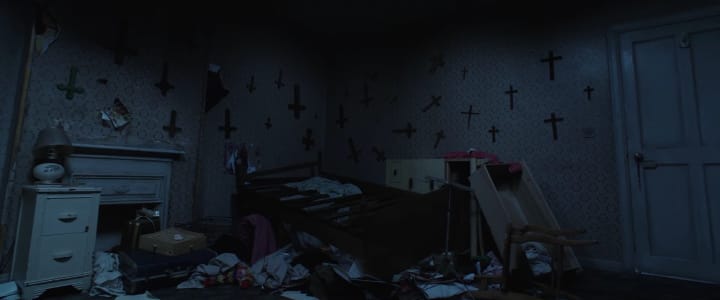
Look at the way it is designed. This happens when the haunting inside the room is about to take place.
Let's first look at the Conjuring's blue tint that, by now, we know of by looking at the way in which the room is lit up. The thing we are made to see is the wall filled with crosses. Not only that but look at the wall on your left; the crosses are upside down. As we progress right, the crosses are still turning upside down; we have some in the process of doing so. This shows us that the haunting is linked into the religious aspect of the film via characters as it is normal people who have donated the crosses.
The fact that the crosses turn anti-clockwise is always a point of interest. Look at this method in the middle of the cross-turning process and how it is made to look darker than all the other walls. This is because the filmmaker wants you to look closely for the movement and has designed it in a way that you're waiting for something because:
- You're watching quite closely
- The pace is slow and steady
- There is little lighting and a blue tint that you've become accustomed with
'The Nun'

This is the frame we will be analysing, you will find it again further on in the article
The religious implications in The Nun are many and found all around the film. Apart from the set and characters, there are many symbols and icons around the film that may suggest various things with various different religious meanings.
How does the theme work in the film?
There's something very uncomfortable about the religious themes in The Nun. Even though we've already talked about the links you could make between hauntings and religion and therefore, this is the same link we make between possessions and religion; we also need to talk about the various icons and symbols in The Nun that show us something slightly different to the normal things we're used to in The Conjuring Universe. We are bombarded with these symbols constantly in order to make connections, possibly in preparation for links seen in future films.
What kinds of camera/lighting/design techniques are used to achieve this?
The frame we're looking it is obviously filled with both dark and light religious symbolism. We have the juxtaposed characters in the film who are symbolised perfectly by objects with only one of them being present and the colours in the shot are absolutely divine for creating meaning. Let's take a closer look at the frame then:
Frame

Look at the symbolism of character and the colours in the shot
There's two main things we need to look at in this shot:
- The contrast between light and dark
- The symbolism of characters
As we can see, Sister Irene is in the dead centre of the frame and is holding a lamp. Not only is this a saviour Florence-Nightingale-Style image, but this is also the point we will take as the way the frame cuts into two.
On your right we have the crosses and the burning orange colour, symbolising the burning faith of the main character and the "light" of the abbey. This hints at the ending; the faith will eventually overcome the evil.
On your left we have the dark abyss. We see nothing but the fading brick wall which disappears into the black nothingness; directly contrasted by the other side of the frame. This is meant to show the "crossing of the threshold" that our main character must do in order to stop the evil forces.
The fact that she is holding a lamp not only gives her a light source in order to light up her white costume, but also shows that she is the saviour character. She carries the light into the dark and forces the darkness away.
The symbolism of the characters is seen so well through this scene even though only one of them is present. Both characters are symbolised by the same item. Sister Irene is the first character; Valak is the second character. The item is the crosses as a plural, not as a singular. As a singular, you would probably get just Sister Irene as a part of the symbol, but by having multiple crosses, you can symbolise an evil force as well. This is again, the mass hysteria. The fact that there are many crosses must mean that there is something that many people fear down there.
Where have we seen that before? In The Conjuring 2 when people "donate crosses" to the Enfield House, it symbolises the demon approaching. Notice how the people who have watched these films become accustomed to associating the crosses (as a plural) with an evil force, but the cross (as a singular) with a good force. This is something that would come into great use in your next project as it is such a subtle symbol.
4. Violence - 'The Conjuring'

This is the frame we will be analysing, you will see it again further on in the article
Violence, especially violence against the innocents, has been a theme in horror since the 19th Century. To give you some examples: Dr. Jekyll and Mr. Hyde Chapter 1, when the young girl is trampled on—or Frankenstein Chapter 23 when Elizabeth Lavanza is ripped in half and brutally murdered on her wedding night by a frightening monster—or even The Cask of Amontillado when an unsuspecting man is set alight in a terrifying revenge tragedy.
How does the theme work in the film?
The Conjuring also uses the "violence against the innocents" theme, but in a slightly different way. Instead of having a simple theme of violence, the theme is tied in with the hauntings and possessions—making whatever is haunting the house seem all the more malevolent and dangerous.
What kinds of camera/lighting/design techniques are used to achieve this?
Again, to the average viewer, this frame may seem quite simple, but we're going to take a closer look at the colours, the lighting techniques and the way in which item placing is symbolic and creates meaning in the film. This is all part of the atmosphere and also, part of the story—so if you are to succeed in making a horror film, then you need to know that each one of these things counts. Let's take a look at that frame again:
Frame
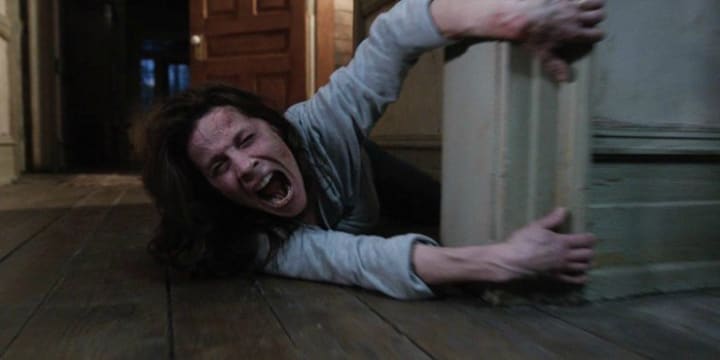
Look at the colours, the shot and the design of the overall frame
The main thing is the colours of the frame. The use of colours not only tells us that this character is being dragged somewhere dark (look at the way the dark colour is used between the wall in which the camera is in and the wall slightly behind it of the hallway). But, it also tells us that the character is being violently dragged out of somewhere familiar into the unfamiliar. The colour we can see that is worn by the character is a very similar shade to the foremost wall, but not the same colour as the hallway wall and therefore creates this familiarity to unfamiliarity. It makes the dragging seems more violent and malevolent, making the audience question the motives of whatever is taking them.
The next thing we can look at is the way in which the shot is lit. We can see the clear creation of depth by having the back lights switched off. It creates unclear boundaries and is very effective for showing a "black hole" sort of atmosphere. Again, we see the classic Conjuring violent space which stays in the middle of the frame but is reflected by both sides. On your back left you'll see darkness that slowly fades into the front right, which is lighter. The acts of violence are intruding upon the family and the home as the darkness is intruding upon the back right of the frame, therefore creating this depth and making it look like the violence is a "black hole swallowing" effect.
'The Conjuring 2'
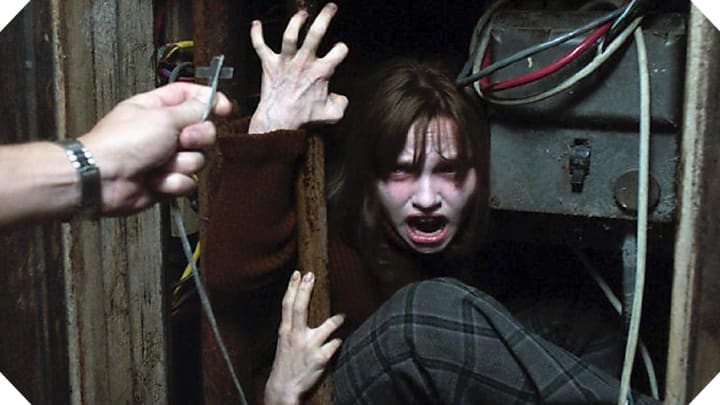
This is the frame we will be analysing, you will find it further on in the article
Violence can include contortion and, in this case it is an act of possession and of haunting. This links all of these ideas together again and, if you want to get the best out of your horror making experience, you need to makes sure there's a link, however small, between these themes. This is the effect used to make whatever is haunting the house seem worse than it actually is.
How does the theme work in the film?
In this film, the theme works by presenting itself as an act of violence caused by a haunting which is, in turn, cause by the possession of the child in the frame. This cycle is repeated over and over again: possession, haunting of objects, act of violence. This is used in the film to get the attention of various people. The acts of violence is the most extreme and get the attention of the Warrens; it is the hauntings of objects that seemingly get the attention of the police and the possessive aspect that gets the attention of everyone else involved.
What kinds of camera/lighting/design techniques are used to achieve this?
The way in which this frame is created would again, seem pretty simple, but with an eagle eye you can pick out various things that are purposefully there to create a more violent atmosphere. Remember, violence isn't only an act and if you want your film to have a better and more effective scene of violence against the innocents, you're going to have to have a violent atmosphere to go along with it. Let's take another look at the frame:
Frame

Look at the way the shot is designed and how the camera is angled
The camera is angled by the door as if someone has opened it. Not quite a POV shot, but closely related to one. Then, we have the camera angled ever so slightly downwards as if looking upon the child from above; again a POV shot to show the angle of the person who found her. The violent atmosphere can therefore, be clearly seen in the massive scratch marks that seem to be on the doorframe.
The design of the shot is very symbolic of violence as it contains this inhumane body contortion by the young girl pushed into a very small space. The small space is made even smaller by the fact that the camera is angled down upon it rather than level. The violence of the body contortion design comes primarily from where we see her hands and the fact that her veins are perfectly visible.
The colours are fairly important as again, we have that Conjuring classic moment of everything fading to black in the background and only parts of something being seen. It doesn't let us know everything, but instead it shows us something that looks a bit uncomfortable. It's a technique that can be highly effective in creating depth and also shrinking a space and creating claustrophobia if used in the correct ways.
'The Nun'

This is the frame we will be analysing, you will find it further on in the article
The theme of violence is very strong in The Conjuring Universe and the way in which each theme has been tied in with the other seems to say that a lot of work has gone into making these films the way they are. I will say that if you want to create an effective horror film, you want to use the malevolent forces to your advantage; don't overuse them, but use them enough so that the audience get a good idea of what to expect from the physical entity of a specific demonic character.
How does the theme work in the film?
In the film, violence is one of the aspects used to showing this malevolent force. The haunting is not so much a haunting of the abbey but, from the very beginning it is established that the haunting is made physical when the character start receiving marks on their body. For example; the scratched on Sister Irene's back when the prayer begins.
What kinds of camera/lighting/design techniques are used to achieve this?
The frame we have here uses various methods of light and dark and, of course, James Wan's famous tinting in order to achieve this very iconic portrayal of violence. Let's take another look at the frame:
Frame
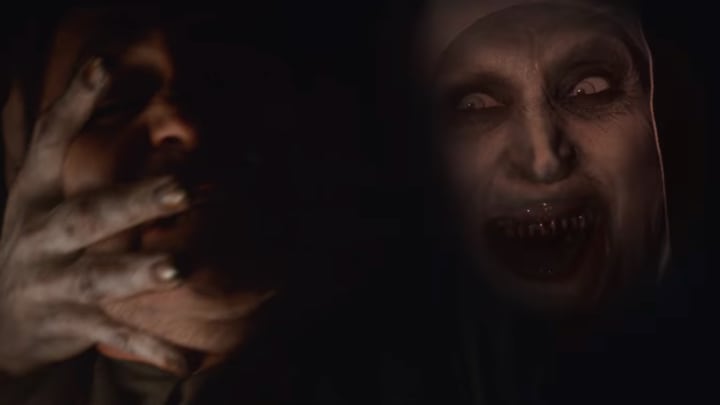
Look at the tinting, the placement and the light/dark contrasts.
First of all, we can establish the following:
- The light/dark contrasts are to show us "what" is there and yet, obstruct the viewer from seeing other things
- The dark is used to create depth so that it seems as if Valak is coming from behind the character
- The placement is used so that the hand is stretched around the character's head and so again, makes it look like she is coming from behind him
- The tint highlights the violence but seems to cover and obstruct the full view of the demon and the back of the coffin
- The light and dark also obstructs the view of how close the demon is to the character and therefore, is making the demon look very close and just behind them
This is all the "surface" components of this frame. If we're looking in-depth at light and dark, then you want to concentrate on the obstruction of the view we get of the facial expression of the character. We can see that the demon's expression is somewhat malevolent and angry; but we don't see the facial expression of the character as half of his face is obstructed by darkness and the other, by the demon's hand. This shows the violence towards the character as the demon is using two types of fear to her advantage:
- The fear of the demon themselves
- The fear of whatever may be in the pitch black darkness
It really is quite a sight to see.
5. History
(Here we will be looking at the posters for clues about the historic elements to the film)
'The Conjuring'
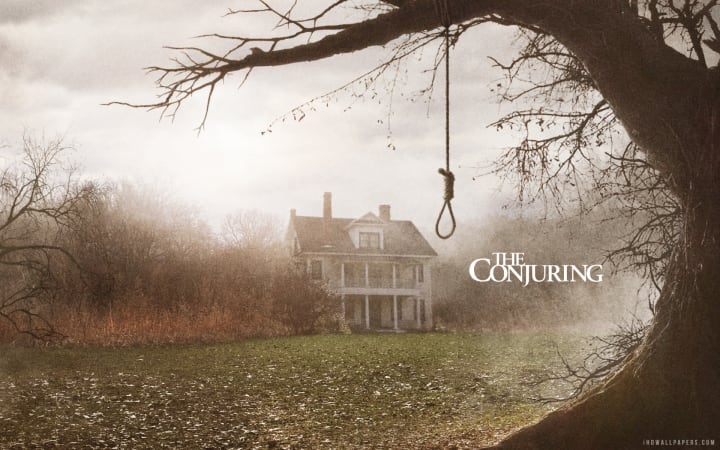
This is an incredible poster that uses colour and placement for historical explanation
Let's analyse this movie poster in terms of what it can tell us about the "history" of the film.
- Through the ways the trees have very little to no leaves, we can see that the place in which this poster takes place is very old
- The fact that the house's colours aren't a pristine white, but rather a greyish white means that this has happened over time. This makes the house look older
- The design of the house is quite old and isn't considered modern. This shows the time at which the event of the film could've happened before it had been investigated
Here's two questions to think about:
- From the poster, how old do you think the filmmaker wants us to feel the film's events are?
- From the poster, what can we gather about past and present? (There's the obvious noose in the middle)
'The Conjuring 2'

Look at the way the poster has been made to look very "70s"
The main thing about this poster is to find out when the film is set. We can see that in a few ways. Here are some:
- Again, we have the barely visible trees without leaves making the set look old
- We have the three windows which is a sign of the age of the property; it isn't a modern 21st Century one, but rather something pre-80s
- We also have a lack of curtains and this floor-length sheet which both indicates the nature of the people who live there and the floor-length curtain again, isn't very 21st Century
Here's a question to think about:
- How would you explain the design of the poster in terms of when the film is set to someone who has not seen or heard of the film?
'The Nun'

Look at the colour and the design of the poster
Now, we're not so much looking at how old the film's event are, we're looking here at the history surrounding the events in the film that are given away by the poster.
- We are given the possibility of these events occurring over a long period of time, maybe even centuries, because of the fact the abbey on the poster looks so old.
- We are given the "exorcist" character dressed in black. Not common of the 21st Century, but also the style of briefcase he carries is a reminder that this film may be set some time other than just the 20th Century. The briefcase suggests it is possibly a mid-20th Century setting at most
Here's a question:
- How does the design of the poster make it look like it could've happened at any particular time? Are there any specifics?
Conclusions
Well, we've finished covering the top five themes covered in The Conjuring Universe and I hope you've learnt a bit about its filming and the way the films are designed. The Conjuring Universe is a truly great set of films to learn from and I hope you take inspiration for your next project from this!
About the Creator
Annie Kapur
200K+ Reads on Vocal.
English Lecturer
🎓Literature & Writing (B.A)
🎓Film & Writing (M.A)
🎓Secondary English Education (PgDipEd) (QTS)
📍Birmingham, UK




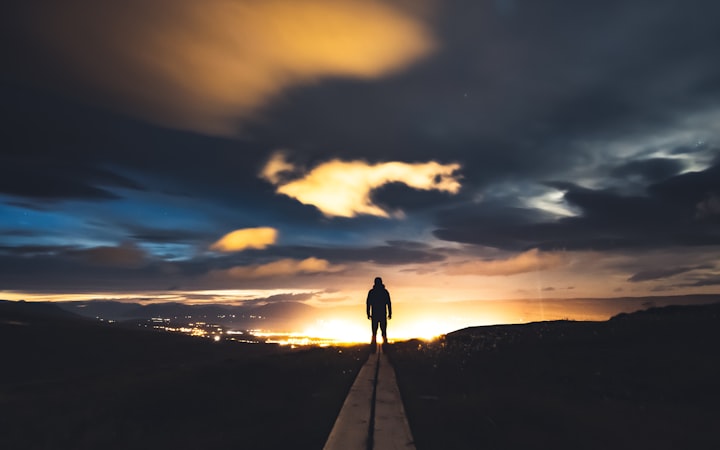

Comments
There are no comments for this story
Be the first to respond and start the conversation.